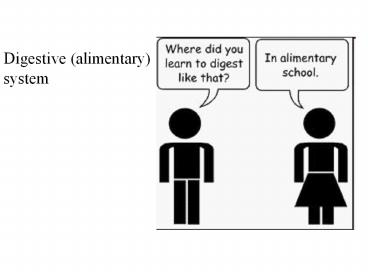Digestive (alimentary) system - PowerPoint PPT Presentation
Title:
Digestive (alimentary) system
Description:
Digestive (alimentary) system - tubular passage for digestion, absorption and assimilation of nutrients and the egestion of food residue; begins at the mouth and ends ... – PowerPoint PPT presentation
Number of Views:205
Avg rating:3.0/5.0
Title: Digestive (alimentary) system
1
Digestive (alimentary) system
2
Alimentary canal
- tubular passage for digestion, absorption and
assimilation of nutrients and the egestion of
food residue begins at the mouth and ends at
the anus
3
Chemical Breakdown
Catalysts are substances that speed up chemical
reactions and aren't changed by the
reaction. Enzymes are proteins that function as
biological catalysts.
- They breakdown large molecules into smaller
molecules - Enzymes are named for the food they breakdown.
- Enzymes are found in the alimentary canal
4
Mouth the opening through which an animal or
human takes in food
Mouth Chemical breakdown Food Enzyme Produ
ct Starch Amylase Maltose Physical
breakdown Chewing
5
(No Transcript)
6
Stomach a saclike enlargement of the alimentary
canal forming an organ for storing, diluting,
and digesting food Chemical breakdown HCl and
Pepsin to kill bacteria Physical
breakdown Churning with mucus
7
Small intestine lies between the stomach and
colon, consists of duodenum, jejunum, and ileum,
secretes digestive enzymes, and is the chief site
of the absorption of digested nutrients
The small intestine is between 5 and 6.7
meters long
8
Duodenum the first portion of the small
intestine, from the stomach Liver, pancreas and
gall bladder secrete juices into the duodenum
9
(No Transcript)
10
Pancreas a gland, near stomach secretes
amylase and lipase into the intestine through one
or more ducts and also secretes the hormone
insulin
Nutrient Enzyme Product Starch Amylase Malto
se Lipids Lipase Fatty acids
glycerol
11
Jejunum middle portion of the small intestine
between the duodenum and the ileum Millions of
Villi cover inside of the small intestine, they
make enzymes and absorbed into the bloodsystem
12
Ileumthe third and lowest division of the small
intestine Enzymes continue to breakdown
Nutrient enzyme Product Maltose Maltase
Glucose Sucrose Sucrase Glucose and
fructose Proteins Protease Amino
acids Lactose Lactase Glucose and
galactose Lipids (fat) Lipase fatty acids
and gylcerol
13
Large intestine terminal division of the
vertebrate intestine that is wider and shorter
than the small intestine divided into cecum,
colon, and rectum reabsorption of water and the
formation of feces
14
Colon the part of the large intestine extending
from the cecum to the rectum
15
Rectum terminal part of the intestine from the
colon to the anus
16
Anus the opening at the lower end of the
alimentary canal, through which the solid refuse
of digestion is excreted
17
(No Transcript)
18
(No Transcript)































